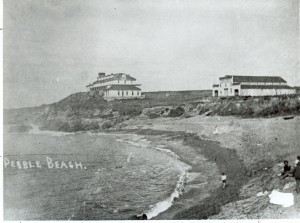By June Morrall
Whenever times got rough, the villagers of Pescadero got together at Pebble Beach as they did on a Saturday in May of 1892.
It was just like old times: Early in the morning a caravan of coaches “bearing all kinds of humanity….to indulge in the pleasure of picnicking…” rolled over the hill from Pescadero to the seashore. Once there “…they stretched out on the clean pebbles and chatted for an hour while turning the pebbles over and searching for beautiful carnelians and other rare stones. When they tired of this quiet enjoyment, they tossed pebbles at one another. In the background the ocean murmured.”
This was the Pebble Beach the oldtimers loved.
Serene as the South Coast scene was, there were visions of “Coburnville” in the Pebble Beach-goer’s heads. One of millionaire landowner Loren Coburn’s men had already constructed a very visible hitching RACK—-for use by the future hotel and its beach-bathing guests.
The rumors grew as loud as the roar of the Pescadero waves on a stormy January morning: The railroad was coming. Coburn talked officials into building a station at Pebble Beach where he was building his new hotel, and, according, to the scariest story, “would kill the town back in the hills,” (and that would be Pescadero.)
The reality of Coburn’s hotel was what the locals were talking about at Pebble Beach on a pretty Saturday in 1892.
Now more details were available: It was 50-room hotel: The lumber was being shipped from San Francisco to Pigeon Point. Coburn’s Pebble Beach Hotel was to be a two-story establishment with porches and porticoes at the mouth of Bean Hollow. And it was set to rival the most famous California hotels of the day: the Coronado and the Del Monte.
————-
Are you interested in knowing more about architectural styles, including a porticoe mentioned in the Coburn chapter above. I have found the little book (below), “How to Read Buildings” fun and helpful, although it refers more to buildings you’d see in cities.


